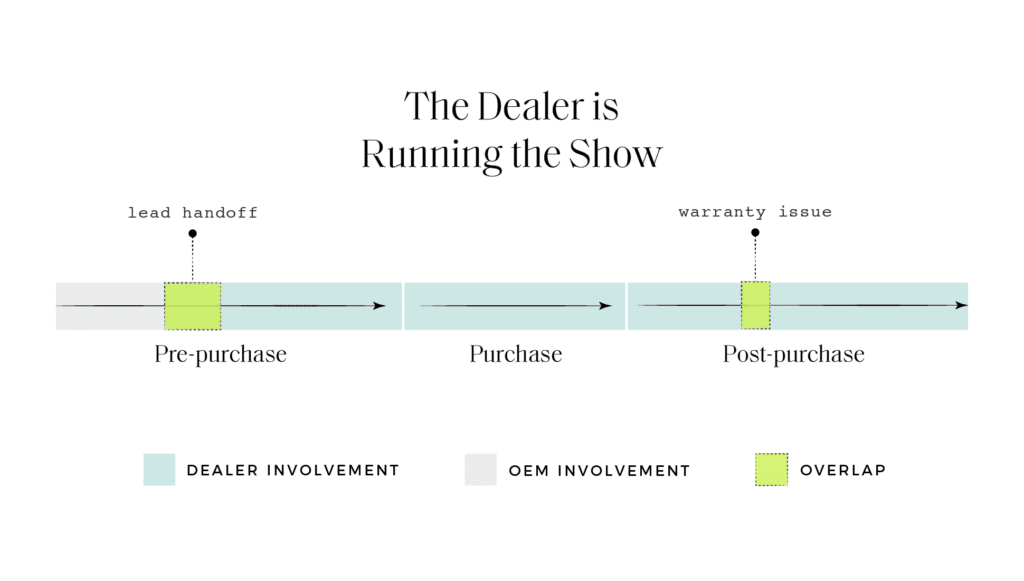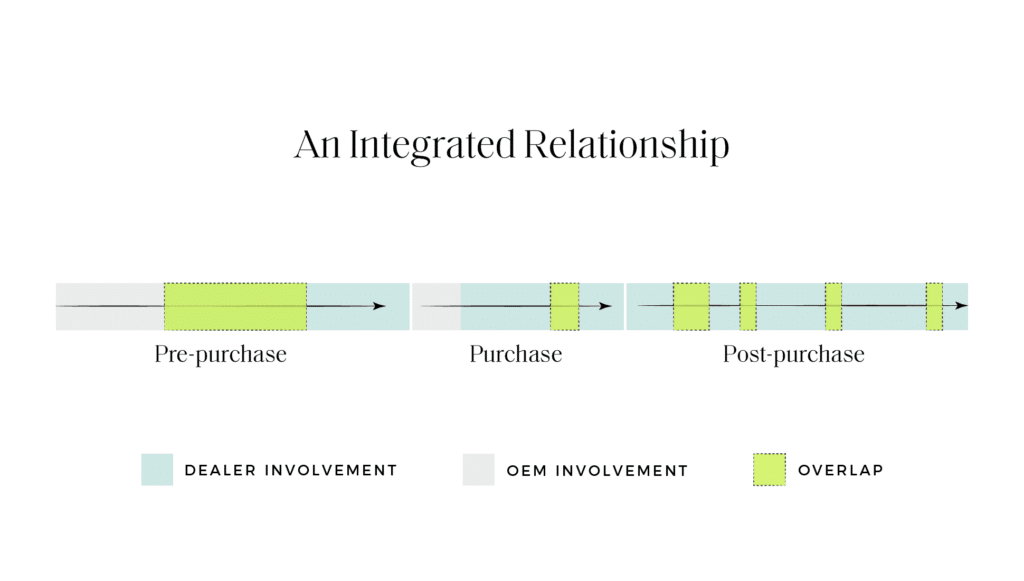Who owns the customer relationship: OEM or Dealer? What do you think your customers would say? Pause and think about that for a moment.
You might be saying, “Well, it depends”, and I would agree with you. In reality, both OEMs and dealers are vying for a meaningful relationship with the customer, each with a distinct role to play. But you should ask yourself: are you leveraging your role effectively in shaping the customer relationship?
More importantly, if you knew a slight improvement in how you managed the customer relationship could increase your sales conversion rate by 2%, would you do it? What about an increase in customer lifetime value by 10%? Now we’re talkin’. How the customer views your relationship and who they tell about it can be a business accelerator or killer.
Aside from a handful of elite, customer-centric OEMs, I see significant opportunities for OEMs to take a more active role in the customer relationship. I suspect a variety of things serve as barriers to making improvements—limited resources, tension with dealers, skillset, technology, etc. Here are a few to consider.
Tension
At Element Three, we’ve spent over 15 years observing the tension that exists between the OEM and dealers about who owns the customer relationship. Both aim for a lifelong customer, which works well in situations where OEMs have exclusive dealers but becomes particularly challenging when the dealer operates with a mixed lot.
Picture this: You’re an executive at Brand A, and a customer is on their way to the dealer (mixed lot), prepared to purchase their third product from your brand. They’ve done their research, and they’re excited, but after a conversation with the dealer, they are influenced to explore a product from Brand B and ultimately make that purchase instead. Yikes. What do you do about this as Brand A? Do you even know it is happening? The situation can’t be eliminated, but it can be mitigated. As an OEM, there are things you can do on the customer relationship front that respect the dealer’s turf but give you as much influence on customer purchase decisions as possible.
OEMs would typically enjoy having a little more control of the customer relationship. There’s a lot to gain from having a more intimate understanding of satisfaction and feedback directly from the customer. It is also expensive to pull off and often not in the wheelhouse of organizations designed to be great at manufacturing. On the other side of the coin, most competent dealers would prefer that their OEM partners generally get out of the way and let them handle as much of the buying process as possible. Once a lead is handed over to the dealer or a prospect steps on their lot, they don’t want the OEM putting their hands in that process. But hang on a minute. The OEM paid a lot of money for that lead, and what actually motivated that prospect to walk on the lot? The dealer’s reputation? The OEM’s new product and great brand?
It’s clear where the tension comes from.
Buying phases and control
When thinking about the customer relationship, it’s important to look at a customer in three core phases: Pre-purchase, purchase experience, and post-purchase. These phases matter because they are the milestones where you are taking advantage of or missing opportunities to build a relationship with the customer. These are also the phases when a customer may decide to end their relationship with you.
In my experience, the OEM gives up far too much control of the customer relationship. Here is what I see a lot of in the graphic below. This is overly simplified, but you’ll get the point…

It doesn’t not work, but the dealer is definitely running the show. I understand this is by design — there’s turf, contracts, politics, etc. — but the design can improve. OEMs have great dealers for the most part, and they are likely providing a fantastic customer experience. However, do you actually think having so little involvement in the relationship as an OEM gives you the best chance of converting that customer and retaining them for future purchases? Your dealers and product better be flawless for this to be sustained.
In this scenario, the OEM is faceless and is mostly just existing in the marketplace for the customer to window shop. The customer learns about your product and offering through word of mouth, probably some events here and there, social media, your website, and exposure to the product when they walk on the dealer’s lot. Don’t get me wrong, this is super common and OEMs have made this work extremely well for themselves. Still, investing more involvement and a stronger relationship could move the needle further (re: sales conversion rate and customer lifetime value).
What would it look like for the OEM to join in on the party a little more? Check out this next graphic:

I’m going to generalize, so these suggestions may not be right for every OEM’s situation. Take it with a grain of salt.
This is where I see things fall apart for OEMs — and where I think they can carve out a more meaningful relationship with the customer without wrecking things for their dealer: Effective brand building, lead generation & handoff to dealer, warranty registration, and post-purchase relationship and capturing key moments.
Effective brand building: Building a strong brand is more than just marketing; it’s about shaping perceptions and influencing decisions. Think about what you can do to start a relationship with a prospect as early as possible (events, web tools, merch, inside sales, etc). By investing in effective brand-building strategies, you’re attracting customers and establishing trust and loyalty that can translate into a lucrative customer lifetime value.
Lead generation & handoff to dealer: This is one of the most common areas of opportunity I see. Generating leads is only the beginning; how those leads are distributed to dealers can significantly impact sales conversion rates. Establishing seamless processes for lead handoff ensures that potential customers receive consistent, personalized experiences from initial contact to purchase, maximizing the chances of conversion. Too often OEMs simply toss a lead over to a dealer and wipe their hands clean. Don’t do that. You need to care more about the customer’s shopping process and the ways in which it can be optimized. A quick suggestion post-lead handoff: ask your prospects if and when a dealer contacted them and how they would rate their experience – you’ll learn a lot.
Warranty registration: Warranty registration might seem like a mundane task, but it’s a critical touchpoint for customer satisfaction and loyalty. By streamlining the warranty registration process and proactively engaging customers post-purchase, OEMs can demonstrate their commitment to product quality and customer care, fostering stronger relationships and reducing churn. If you struggle with getting a 100% completion rate on customer warranties, figure out why and fix this immediately.
Post-purchase & ownership experience: The post-purchase phase is where lasting relationships are cemented or lost. Providing exceptional post-purchase support and ownership experiences not only enhances customer satisfaction but also increases the likelihood of repeat purchases and positive referrals. Consistent communication, proactive problem-solving, and value-added services can turn dissatisfied customers into loyal advocates for your brand. Nurturing a customer post-purchase can be expensive for dealers and OEMs, but the value of a repeat customer is typically worth it.
I believe it is the OEM’s job to figure out how far they can push the boundary without it smelling and looking like they are selling directly to the consumer, thereby causing a riot with their dealer partners. Finding that boundary maximizes the relationship equity that both the dealer and OEM can bring to the table for the customer. So, how are you doing and where do you need to push in a little more?
A personal example
I purchased a John Deere zero-turn lawn mower a few years ago. Thanks to JD’s effective brand-building, here’s what my fairly short pre-purchase experience looked like. My parents had a John Deere, my grandpa (who was a farmer) was a John Deere enthusiast, and it only made sense that I was going to buy a John Deere. I didn’t consider anything else. I did a little research before going into the dealership, but honestly, not a ton because I wanted to hear what the dealer recommended based on what I was looking for.
This was an exclusive John Deere dealer, so there was no risk that they were going to flip me into a Toro (competitor). The store was freakin’ awesome. The dealership employees were great. The experience was fast and left nothing to be desired. They even gave me free swag. I ended up purchasing a Zero-Turn Z300 Series, filled out my warranty, and thought the overall process was enjoyable. Purchase experience complete.
Post-purchase. Here’s where things get a little dicey. My mower keeps having issues with the blade deck. I bump into the world’s tiniest roots, which bends the deck out of alignment, causing the mower to cut the grass extremely short, regardless of the setting. So, I have to regularly pay hundreds of dollars at a time to get it serviced. As a customer, it’s frustrating. I think “a $3k mower shouldn’t have these problems”. Now, the service process with the dealership is amazing. They do home pick-up and drop-off for service, and their turnaround time is impressive, but that doesn’t fix the underlying product issue I am having.
What could fix this? Maybe a phone call from JD corporate to check in on things. They likely can’t reverse what I perceive to be a product flaw, but they could give me a service voucher, turn this into a minor inconvenience, and keep me as a customer the next time I make a purchase.
I have probably received a thousand emails from JD since buying my mower. I haven’t read any of them, but how expensive could it be for me to get a survey or phone call once or twice in the five years I’ve owned the lawn mower where they ask, “is there anything we could do better or address for you?” I’d say yes, and hopefully, they could do a little something about it. Is this hypothetical investment in headcount and processes worth keeping me as a customer? If it prevented me and others from switching to a competitor brand next time around, I’d venture to guess it would be worth it.
The relationship is yours to lose
At the end of the day, the customer owns the relationship and has all the say in where their money and attention go. This is about how you position your strategic assets (brand, product, dealers) to win a customer now and keep them into the future.
Kyler Mason, President




